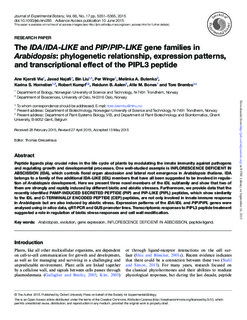The IDA/IDA-LIKE and PIP/PIP-LIKE gene families in Arabidopsis: phylogenetic relationship, expression patterns and transcriptional effect of the PIPL3 peptide
Vie, Ane Kjersti; Najafi, Javad; Liu, Bin; Winge, Per; Butenko, Melinka Alonso; Hornslien, K; Kumpf, Robert; Aalen, Reidunn B.; Bones, Atle M.; Brembu, Tore
Journal article, Peer reviewed
Permanent lenke
http://hdl.handle.net/11250/2357492Utgivelsesdato
2015Metadata
Vis full innførselSamlinger
- Institutt for biologi [2573]
- Publikasjoner fra CRIStin - NTNU [38070]
Sammendrag
Peptide ligands play crucial roles in the life cycle of plants by modulating the innate immunity against pathogens and regulating growth and developmental processes. One well-studied example is INFLORESCENCE DEFICIENT IN ABSCISSION (IDA), which controls floral organ abscission and lateral root emergence in Arabidopsis thaliana. IDA belongs to a family of five additional IDA-LIKE (IDL) members that have all been suggested to be involved in regulation of Arabidopsis development. Here we present three novel members of the IDL subfamily and show that two of them are strongly and rapidly induced by different biotic and abiotic stresses. Furthermore, we provide data that the recently identified PAMP-INDUCED SECRETED PEPTIDE (PIP) and PIP-LIKE (PIPL) peptides, which show similarity to the IDL and C-TERMINALLY ENCODED PEPTIDE (CEP) peptides, are not only involved in innate immune response in Arabidopsis but are also induced by abiotic stress. Expression patterns of the IDA/IDL and PIP/PIPL genes were analysed using in silico data, qRT-PCR and GUS promoter lines. Transcriptomic responses to PIPL3 peptide treatment suggested a role in regulation of biotic stress responses and cell wall modification.
